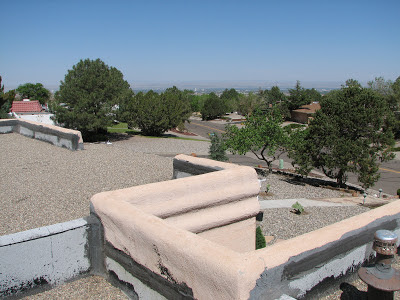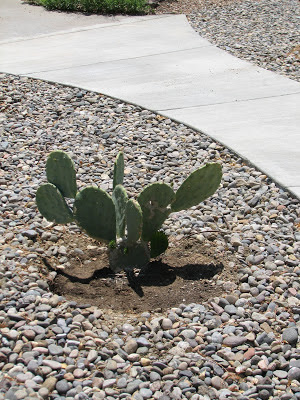Before we came to Albuquerque, I had never heard of a swamp cooler. Also called evaporative cooling, it is an alternative to air conditioning that works best in dry climates. The more I read about them, the more I thought it would be a great option for our Abq house. The advantages are: it uses only 25% of the electricity that air conditioning requires, you need to keep some windows open for it to work properly (I hate having the house all closed up), it creates cool, not cold air (I'm not a big fan of air conditioning, as someone who's always cold), and it humidifies rather than dries out the house. Perfect for this climate and for me, or so I believe.
With daytime temps reaching the 90's this week, Stephen decided it was time to hook up the swamp cooler that came with our house. We had been pretty comfortable in our house so far this spring, even
though it has routinely been in the 80's. It gets cool at night because
of the elevation, we have some trees in our yard to provide shade, and
although our house isn't made of the traditional adobe bricks, it is a
one-story, thick-walled, light-colored stucco. We looked around and
decided that this architecture probably wasn't just an aesthetic
tradition, and decided to try to purchase a house that was suited to the
climate! Because Abq does experience below-freezing temperatures a few times a year, you have to unhook the water lines and cover up swamp coolers during the winter. Our unit is on the roof, so Stephen bought a ladder on his way home from work yesterday, and this morning we ventured up to scope out the situation. I hadn't been on the roof before, but Stephen had gone up with the inspector before we bought the house.


Here we are on the roof. The part sticking up is the living room, with its high ceiling.
 |
| Roof stuff. |
 |
| The Swamp Cooler |
The way evaporative cooling works is that water is pumped over corrugated honeycomb-type stuff called a pad, runs down, evaporates and cools the air, then the cool moist air is pumped into the house by a giant fan. Only a small part of the unit is taken up by the pump and the pad, the rest is the big cylindrical fan. It's a really simple technology. I thought it was awesome. Here is Stephen getting ready to hook up the copper water line.
And here is the inside of the unit:
When it was all hooked up, Stephen had me go into the house and try the different settings. He decided that the pump was shot, and went to the hardware store to get a new one. Soon after he returned, we were in business. Annabelle seems a little put out by the new noise and air current coming from the hallway ceiling, but the other residents are happy with it so far!
While we were up there, Stephen had me clean out the canales,which are the openings in the side of the roof to let water drain off. In our back yard, one of the canales is attached to a downspout that sends the water out onto the small patch of grass.
While I was on the roof, I took some pictures of the view.
 |
| The front yard. |
 |
| The back yard. |
|
And this is my Albuquerque hat. This is the hat everyone wears while hiking or working in the yard here. I'm "in!"



























